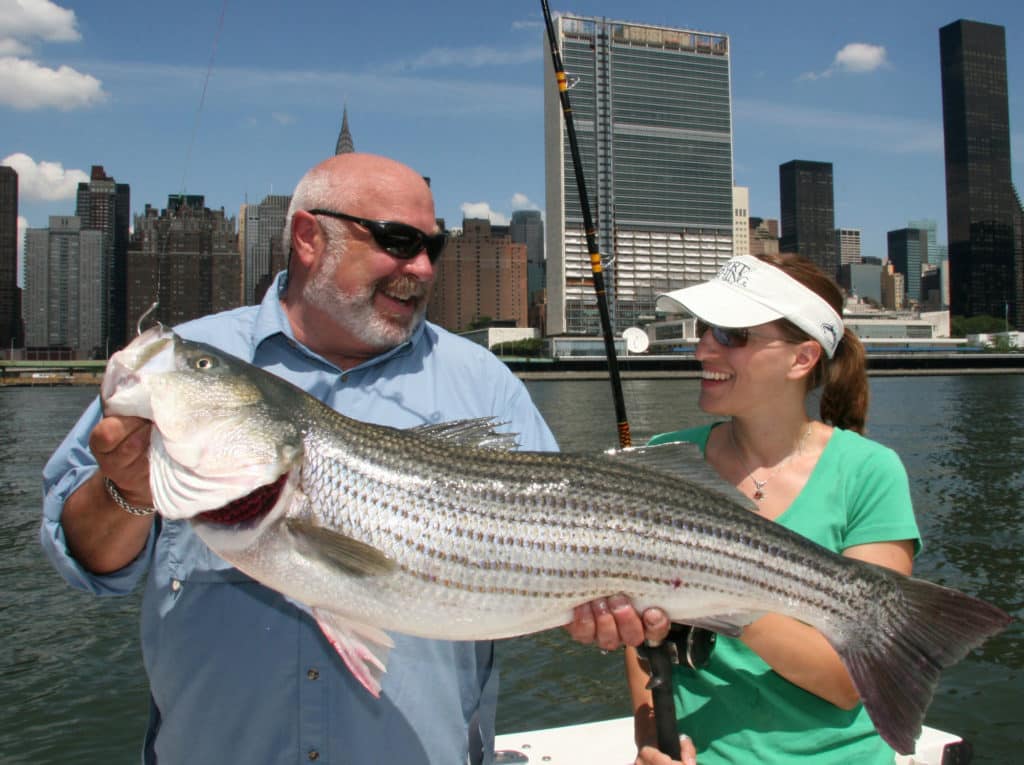
If you walk into any Mid-Atlantic or Northeast tackle shop, fishing club or shady dockside bar and start talking about circle hooks, expect some wary looks. Circle hooks might be good for the fish, but some anglers don’t like them.
The Atlantic States Marine Fisheries Commission rules require anglers to use non-offset circle hooks when fishing bait for striped bass. Some stock assessments show that stripers are overfished and experiencing overfishing. Circle hooks reduce release mortality.
Despite some circle-hook skepticism, captains and pros have used them for years. They say the conservation-minded hooks work just as well as traditional J-hooks, if you know how to rig them.
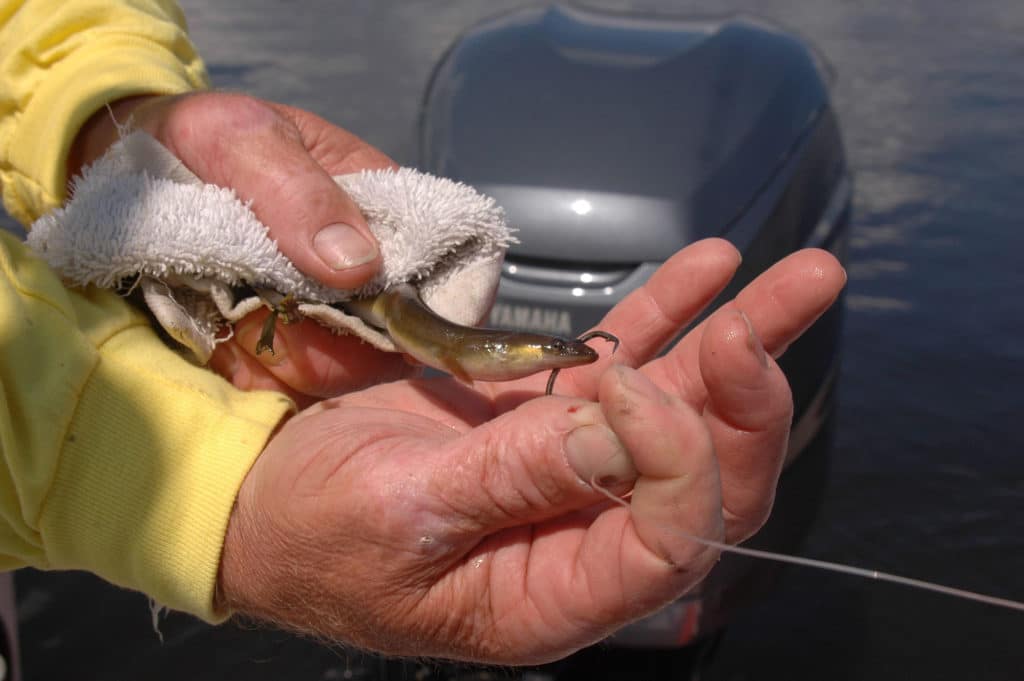
Fishing With Eeels
In late winter, Capt. Kenny Louderback slow trolls live eels off Virginia’s Eastern Shore. He fishes up to 10 rods, using planer boards to spread out the lines. The tactic produces a lot of slack line between the rod tip and the bait, which can impede striper hookups on circle-hook rigs.
To improve his odds, Louderback says he waits until the fish pulls line off the reel before he takes the rod out of the holder. He also uses a lightweight circle-hook rig.
He snells an 8/0 Gamakatsu circle hook to 4 feet of 50-pound fluorocarbon, capped with a 150-pound-test barrel swivel. He slides a small, ½-ounce egg sinker onto his 30-pound monofilament mainline, and then ties the mainline to the swivel, creating a Carolina rig.
To control the bait’s depth, he uses a heavier egg sinker. “I want just enough weight to keep my baits just below the surface,” he says.
Eels are slippery and very uncooperative. Given a chance, the slimy worm ties itself in a knot or slinks overboard. Louderback hooks the eel through the nose so it swims straight without tangling the line.
Louderback says circle hooks make it more difficult for him to catch striped bass with eels, but he’s made the switch to improve the release survival of his catch.
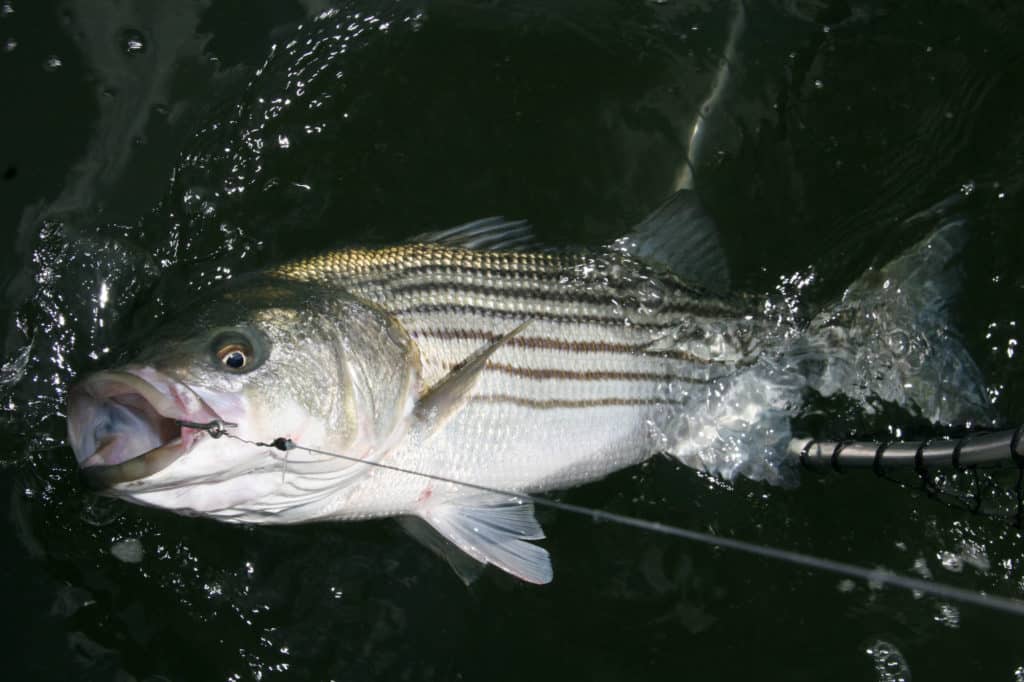
Chesapeake Bay Striped Bass
Seventy percent of the world’s striped bass come out of Chesapeake Bay, and Maryland anglers have perfected methods for catching these fish year-round. With the new circle hook mandate, those traditional approaches must change.
However, Capt. Greg Shute favorite time of year to target striped bass occurs in late spring and summer, when he anchors along a drop or channel edge and fishes menhaden chunks and live spot.
To fish cut menhaden, Shute uses a bottom rig with a 6/0 to 8/0 light-wire circle hook, made from narrower, more malleable wire. “I like a light-wire hook because it pierces the fish’s jaw,” he says.
He snells the hook to 18 inches of 25-pound fluorocarbon, and ties the leader to a swivel. He threads a fish-finder slide and bank sinker onto his 20-pound-braid mainline, and then ties the mainline to the swivel and leader.
Shute lightly passes the hook through a small piece of the chunk bait so the bait doesn’t interfere with the hook gap.
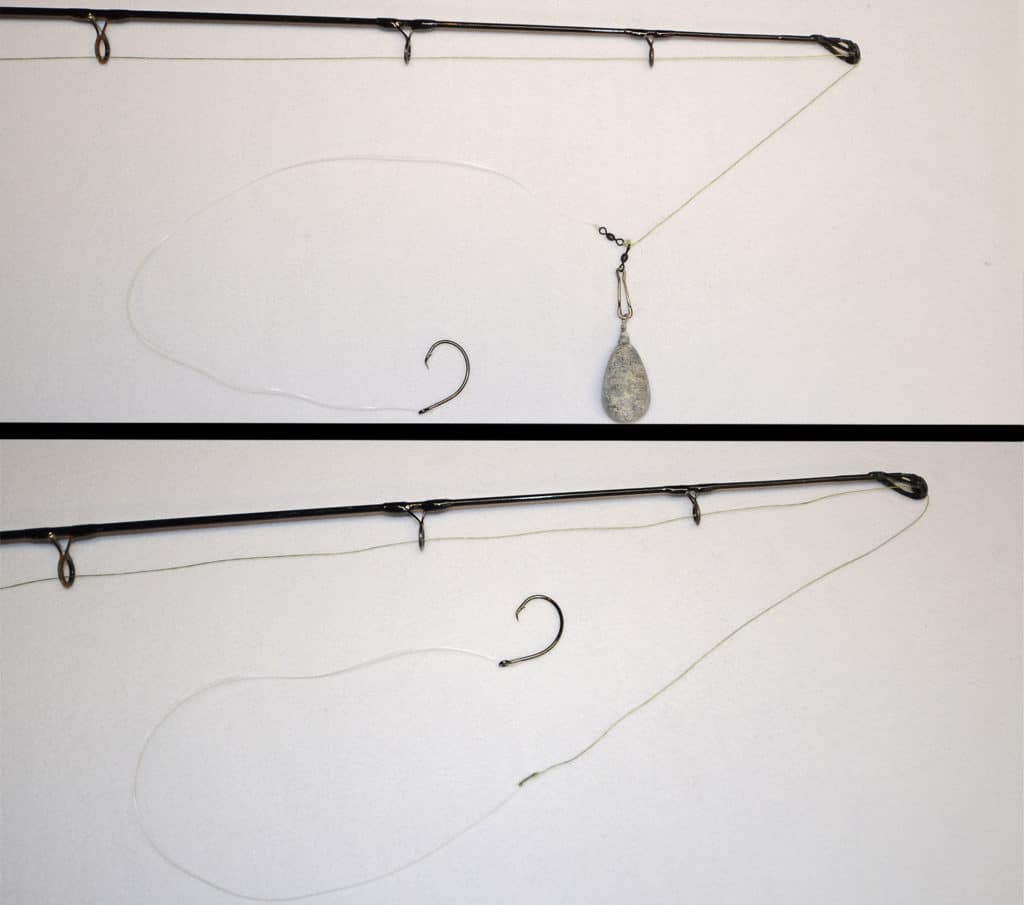
When he uses a live spot, Shute creates the same rig, but leaves out the swivel and sinker. He ties the leader directly to the mainline. “If I need a little extra weight I’ll pinch on a split shot,” he says.
He runs the hook through the spot’s back, behind the head and in front of the dorsal fin. “This encourages the bait to swim down,” he explains. It also creates a solid connection without deep-hooking the bait.
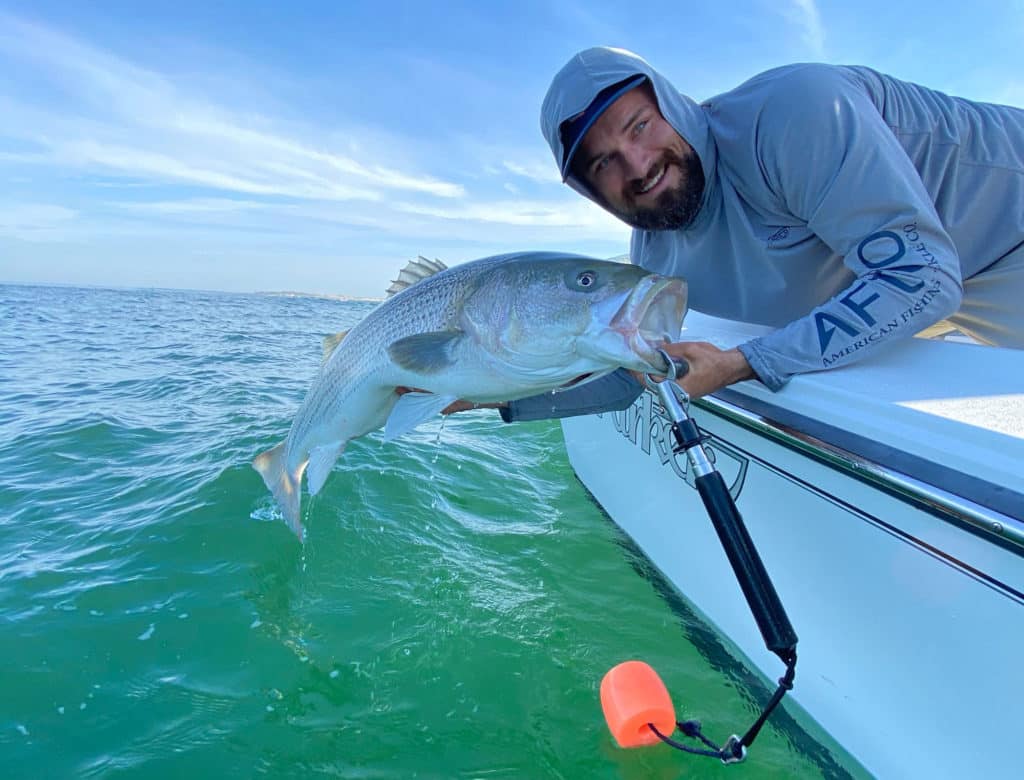
New Jersey Cow Striped Bass
Capt. Greg Cudnik targets striped bass off the famed Long Beach Island in central New Jersey. From spring through fall, Cudnik chases striped bass in the ocean, inlet and back bays with live spot, eels and menhaden.
To fish a live spot or eel, Cudnik chooses a 5/0 circle hook. For live menhaden, he upsizes to a 9/0 circle hook. He prefers a wide-gap circle hook, like the Mustad 39951, that he can dig a little deeper into the bait.
Cudnik snells the hook to 25 inches of 50-pound fluorocarbon tied to a small, 230-pound-test swivel. He passes his 30-pound braid mainline through a ¾-ounce egg sinker and ties it to the other end of the swivel. He wants to keep the bait on or near the bottom with as little weight as possible. “I don’t want the fish to feel the weight,” he says.
When he fishes live spot, Cudnik hooks the bait in the mouth and out the cheek plate for a solid connection. He hooks a live menhaden near the tail. “The tail presents a solid place to insert the hook,” he explains, adding the bait swims naturally and the tail doesn’t inhibit the hook gap.
Cudnik particularly recommends circle hooks to new anglers. “People who haven’t learned how to use a J-hook have an easier time with a circle hook,” he says. Keep steady pressure on the line, and the hook will find its home, he adds.
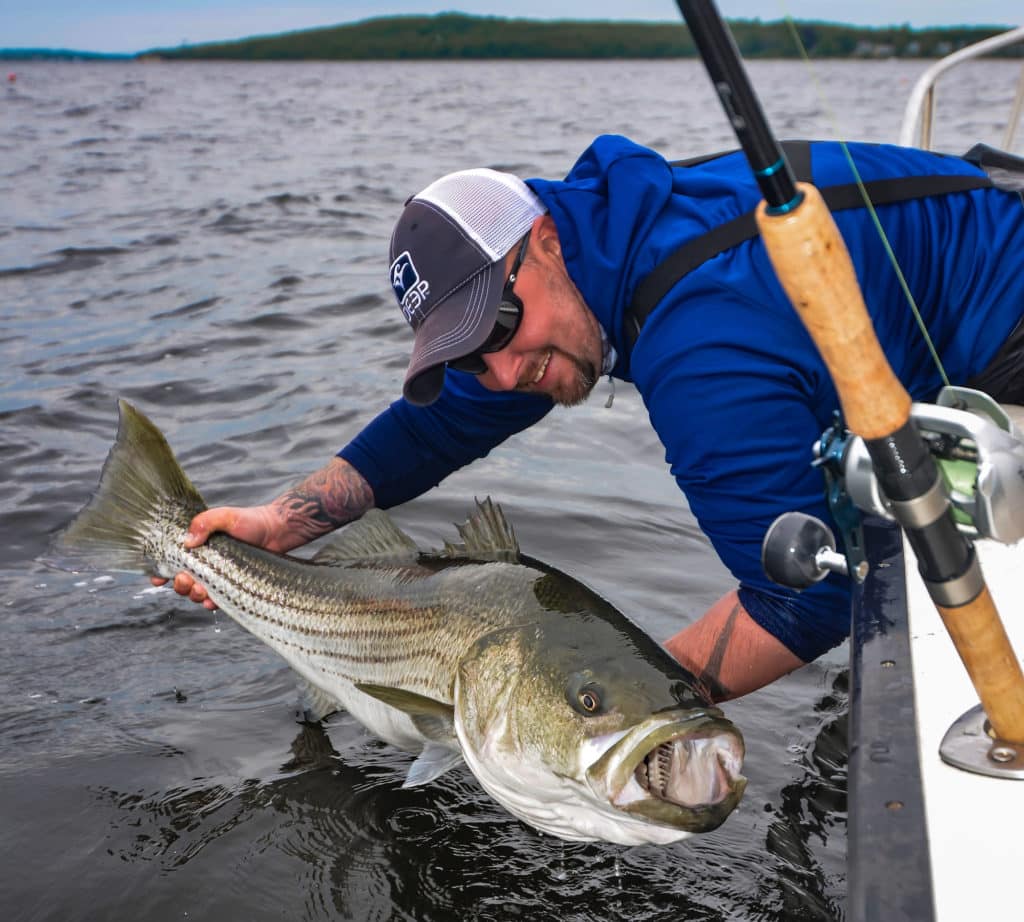
Stripa’ Chowda’
Fishing out of Rhode Island, Capt. Jack Sprengel has made a science of using circle hooks for striped bass. “I’ve been using circle hooks for years because they actually make it easier to hook a big bass,” he says.
Sprengel starts the day catching menhaden with a cast net, gill net or snag rig. With live bait onboard, he heads off looking for bait schools and structure in Narragansett Bay. “When the current is moving, I drift the baits, and when it drops out I bump troll,” he says.
To handle a huge striped bass, Sprengel breaks out a G. Loomis IMX Pro 843 and Shimano Thunnus 6000 reel. He spools the reel with 30-pound PowerPro. “I like traditional four-carrier braid,” Sprengel says, preferring the heavier, more abrasion-resistant line to keep a 50-pound trophy out of the rocks.
The sturdy tackle allows Sprengel to put smooth pressure on a big striper with a light, 25-pound-test fluorocarbon leader. He uses a 30-inch leader in dirty water and 48 inches in clear water. To further reduce distractions for the fish, Sprengel attaches the leader directly to the mainline.
Read Next: Striped Bass Fishing Tips
Hook size plays a critical role in success. As a rule of thumb, Sprengel chooses a circle hook that’s 30 percent larger than the appropriate-size J-hook. A larger hook allows him to hook the bait deeper with plenty of gap to catch the striper’s jaw.
Sprengel has tested his knots for effectiveness and prefers to attach his hook with a Palomar or uni-knot. “The knot allows the hook to pivot,” he says, explaining that when the circle hook pulls into the corner of the striper’s mouth, the hook pivots to drive the point into the fish’s jaw.
He also improves the circle hook’s efficacy by lightly hooking the bait. “Bridling is the best,” he says. Use floss to lash the bait to the hook, providing a strong connection without interfering with the hook gap.
When used correctly, Sprengel says circle hooks work. “It’s a misconception that circle hooks are harder to use,” he says.
While some anglers still might grumble about using circle hooks with bait, pros have adapted and even embraced the new rule. What’s good for the bass can also be good for fishermen.








